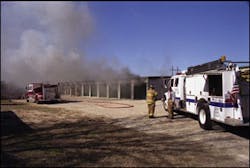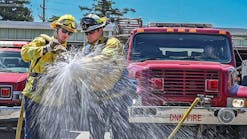Self-storage Facilities: Part 1 - Lightweight Metal Storage Buildings
Self-storage facilities are a booming business nationwide. Consumer demand for storage units can be found everywhere, from cities and suburbs to rural areas. In April 2006, The New York Times reported that there are 45,365 self-storage facilities in the U.S. They cater to the storage needs of individuals, families and businesses.
The variety of items being stored in self-storage units is limitless – personal items, furniture, mattresses, appliances, boxes, files, cars,boats, commercial and contractor inventories, tools and equipment – and the unknown factor. Self-storage units occupy three principal types of structures:
Existing commercial buildings that become vacant and are converted to self-storage facilities. These could be multi-story buildings that at one time were factories or mercantile occupancies. Pre-fabricated self-storage units made of lightweight metal partition walls or wire cage-type partitions are installed within existing floor areas. Firefighters should be aware of the possible presence of large, commercial service elevators for moving contents, existing sprinklers modified for individual storage units and automatic alarms. Some structures may contain dry sprinklered systems due to non-heated storage areas. These types of facilities usually are operated during business hours and on weekends. Security is present on the premises during business hours, but there is no 24-hour access for tenants.
New multi-story storage buildings constructed of lightweight steel skeletons. These feature block walls or “panel walls†(large pre-cast concrete walls that are assembled with the assistance of a crane). Storage partitions are assembled in place throughout each floor area. The individual units are made of lightweight metal partition walls or wire cage-type partitions. Such structures usually are sprinklered and have automatic alarms. Although most of them are heated, some floors may not be climate controlled; those sections may contain dry sprinkler systems with no water in the piping. In such systems, air is pressurized in the piping grid. When the sprinkler head is activated from a heat source, the loss of air pressure causes a clapper valve to open, letting water into the piping grid (these usually are found in loading-dock areas). These facilities are open only during daytime business hours and on weekends. There is no 24-hour access, and security is present during business hours.
New lightweight, one-story metal storage buildings. These long, rectangular buildings are laid out in rows with access roadways between them. Buildings are clustered in close proximity because of available space. Usually, these are non-sprinklered buildings with no automatic alarm present. Tenants have 24-hour access availability. To gain access to the storage compound, tenants enter their personal codes, activating the opening of the security gate. During daytime hours, the proprietor or clerk will be on duty. This article focuses on this type of self-storage facility. The other two types of self-storage buildings will be covered in future articles.
Lightweight Metal Storage Buildings
Lightweight metal storage buildings are constructed of a skeleton frame of light-gauge steel covered by light-gauge metal walls and roofing. An overhead garage-type retractable door, secured by the renter’s padlock, provides access to each storage unit. Usually built on cement slabs, the sizes of these building can vary, but a typical size would be about 30 feet deep by 250 feet long, subdivided into small individual storage units.
Units can vary in size – five by five feet, 10 by 15 feet, 10 by 20 feet, 10 by 25 feet, 10 by 30 feet, etc. These compartments can hold contents from the floor to the ceiling; a larger one can store a motor vehicle. A narrow access driveway separates each row of storage buildings, providing vehicle access to individual units.
Principal concerns for firefighters are fire, collapse and hazardous contents.
Light-gauge metal partition walls separate units from one another on the sides and back. The partitions do not extend to the underside of the roof, leaving an opening at the ceiling level between each unit. This lets fire travel horizontally and unimpeded throughout the building. A fire in one unit could extend to the neighboring units once the metal partition wall heats up and conducts to the contents of adjoining units. Firefighters can expect to find fire in numerous units upon arrival.
Two of the most important pieces of information that the incident commander should know about a commercial building fire are the type of construction of the building and what are its contents.
During a fire, command must be aware of a lightweight metal building’s construction and the potential for collapse once the fire communicates from the contents to the structure, which will occur quickly. Then there is the unknown factor: for example, chemicals and ammunition were being stored in the building shown in photo 1. At other sites, units were found to contain automobiles, propane barbeque grills, and hazardous materials and chemicals.
Although some self-storage facilities may have better screening processes than others, for the most part they are dealing with transient clients. No one oversees or takes inventory of what is being stored. No Material Safety Data Sheets (MSDS) are attached to the buildings. Few of these buildings are heated and no sprinkler system or automatic alarm will be present. Self-storage buildings are usually located in commercial zoned areas, so delays in detecting and reporting fires must be expected.
Do firefighters take an aggressive offensive interior attack or a cautious defensive attack? The choice is obvious. Conditions on arrival will dictate. But get the big guns ready.
RECOMMENDATIONS FOR OPERATORS OF SELF-STORAGE FACILITIES
A. Install a fully automatic sprinkler system throughout the facility.
B. Connect the automatic alarm smoke detector to a central alarm.
C. Keep a detailed inventory of what is being stored. If any hazardous chemicals or materials are stored, provide a placard on the outside of that particular unit.
D. Keep an updated transcript of what is being stored in a lock box for the fire department use.
E. In light of terrorism today, owners of self-storage facilities must be more vigilant of who is using their service.
F. Require all hazardous materials or chemicals to be stored in a separate building.
G. Conduct a detailed screening of what is being stored within.
H. Improve the design of building units to limit fire travel and provide a fire rating for exposed metal structural members.
I. Arrange 24/7 telephone availability for the response of the proprietor or an agent familiar with the facility.
FIREFIGHTING TACTICS AT SELF-STORAGE FACILITIES
A. Consider stretching a 2½-inch hoseline with a solid stream tip. This will give you 250 gpm of driving power and reach. You don’t want to get too close.
B. Get down. If something inside blows out, you have a better chance of not wearing it if you’re down low versus standing up.
C. Some facilities may have narrow access driveways between storage buildings. Do not commit apparatus between the fire building and another structure; you may lose it.
D. Start thinking heavy-caliber streams, elevated platform tower ladders, ladder pipes or apparatus deck pipes.
E. A fire in these units will travel fast. It might be beyond the capabilities of a handline on your arrival.
F. You do not know what is being stored. Expect the unexpected. A fire may turn into a hazmat incident. Operate upwind.
G. A well-advanced fire may call for evacuation of exposures and areas downwind.
H. Always wear your mask.
I. Overhead doors in the retractable open position can threaten the safety of firefighters. All the weight of the door is in the open position directly overhead. Fire can weaken lightweight door framing and securing brackets, causing the entire door assembly to collapse.
J. Obtain a generic code from the storage facility to reduce the need to damage the security gate by forcible entry.
K. Visit self-storage facilities in your response area and discuss your concerns with the operator.
L. Conduct hands-on drills with your department. Pre-plans work and they save lives, especially firefighters.
M. Conduct a fire inspection. It is unlikely that you will be able to gain access to individual storage units, but the first step is to identify where hazardous materials or chemicals are stored (i.e., automobiles, boats and propane tanks). Ask the operator to display placards where hazardous chemicals or materials are stored or a transcript of what is stored and where throughout the facility.
N. Ask the operator to furnish Material Safety Data Sheets (MSDS) in a lock box for the fire department, if possible.
Joseph T. Berry served for 31 years with the FDNY, where he worked as a firefighter in Ladder Company 24 in midtown Manhattan before he was promoted to lieutenant and worked in the South Bronx in Engine Company 73 and Ladder Company 42. He worked on the Ladders 3 Bulletin: Firefighting Tactics Procedures in Tenements and Ladders 5 Bulletin: Private Dwellings and Brownstone Buildings. Berry served as a member of the Division 6 Safety Committee and on five line-of-duty death investigation committees. He also worked on the department’s lightweight residential construction and probationary firefighters manuals.






